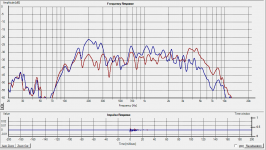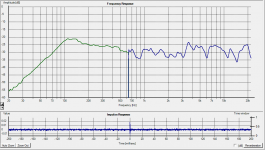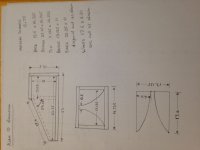I kludged together a Klam over the weekend, but for only one driver, no K-Tube. ~10 liters sealed rear chamber, 24" total length, with ~11.5" of it the Klam aperture. The driver is rear-mounted a bit like an Altec A7, with cone constriction and 45° side panels leading into the Klam mouth. I briefly tried it with an APT80 on top. The high system Q and bandpass gain make for strong output around 150Hz-300Hz IIRC the measurement I did. Whenever I'm within a few meters of it, it sounds terribly boxy, but that goes away when I back up. I could only get ~20 feet from it in my basement. The high sealed f3 makes for not much bass considering the bandpass gain.
I'm a complete noob, so I don't know much about designing/ measuring speakers, terminologies, etc... But when I was playing with the Klam, I found out that I needed a very small back chamber to have the compression required for the bandpass. And when the driver's qts went up, the chamber had to be even smaller.
I made a makeshift Klam with a 8 inch driver that has a 0.22 ish qts yesterday, and the rear volume had to be quite small. (I attached a plant vase and used golf balls for adjustment. LOL)
My hunch is maybe your back chamber for the Faital(0.54 qts) should be very small in order to avoid the boxy sound that you are experiencing.
Just my 2 cents.
I'm a complete noob, so I don't know much about designing/ measuring speakers, terminologies, etc... But when I was playing with the Klam, I found out that I needed a very small back chamber to have the compression required for the bandpass. And when the driver's qts went up, the chamber had to be even smaller.
I made a makeshift Klam with a 8 inch driver that has a 0.22 ish qts yesterday, and the rear volume had to be quite small. (I attached a plant vase and used golf balls for adjustment. LOL)
My hunch is maybe your back chamber for the Faital(0.54 qts) should be very small in order to avoid the boxy sound that you are experiencing.
Just my 2 cents.
My drivers have rather stiff suspension and their actual Qt is more like 0.9 unfortunately. The boxy sound would still be there as it's resonance and reflections from the front chamber surfaces though.
Carl one time said to try a Polk 6" coax in a klam8 - its qts is probably around 0.9 - back chamber on the Patio klam8 is around 0.22 cubic feet not including the speaker - a 30 degree angle version might measure smoother - would be a good thing to mockup and measure
http://img685.imageshack.us/img685/4966/smallklam.jpg
http://img685.imageshack.us/img685/4966/smallklam.jpg
that's pretty respectable response and smoother than what the 40 degree klam8 did with BG20 - if the boost area were occurring somewhat lower then could aid when elevated on a tripod. You could make a 1.5" or so diameter paper passive K-tube and place one end near the dustcap and other end exit near the main aperture - don't know if it would matter much with a midrange. Perhaps drive the K-tube tweeter with whatever cheap can keep up with the Faital.
It's cool that you tried that krazy idea. Looks like the gain BW is about 180 to 300hz. There's also a little gain from 1-2kHz, but it is presumably directivity gain from the internal reflections.
The assorted midrange klam and big K-tube experiments I've tried over the years have frankly been pretty bad, but I've only tried a few times. Maybe it takes hundreds? I did get a mini rocket type thing to sound nice once, and it was with a cheap mini-speaker liberated from a clock radio.
I did get a mini rocket type thing to sound nice once, and it was with a cheap mini-speaker liberated from a clock radio.
AFA slot loading, BBC slots work better and more consistently IME. Often the directivity and subjective sound is improved over direct radiating, at the cost of a minor degradation of freq response smoothness.
So did you give up and decide to go with sealed boxes?
The assorted midrange klam and big K-tube experiments I've tried over the years have frankly been pretty bad, but I've only tried a few times. Maybe it takes hundreds?
AFA slot loading, BBC slots work better and more consistently IME. Often the directivity and subjective sound is improved over direct radiating, at the cost of a minor degradation of freq response smoothness.
So did you give up and decide to go with sealed boxes?
Speaking of BBC slots, what do you guys think of the new JBL slotted woofer thing?
Actually it looks inspired by the RJ 'lemon', except it's shaped more like a rounded duck foot or something.
Actually it looks inspired by the RJ 'lemon', except it's shaped more like a rounded duck foot or something.
Last edited:
why does the 1"id by 5.5" K-tube work so well overall and the klam is so iffy? I would say my klam18/15 and 12 are decent - the Karlsonator has been a success at various scaling, K15 is generally very good to great, K12 can be nice - my tall K18 is very good - little klam can stink on ice. walters seems to like his PA130 klams. Detrimental "sea shell" resonances can built up in some klam - sometimes a good coax will mask those. Damping the front chamber can be done but more a bandaid than fix. Maybe its good to try to work with something around a 30 degree angle from horizontal coupler. IG - what is the approximate angle on your klam?
RJ are great - simple - nice way to combine a good reflex with diffraction slot - can be tuned by path length and/or gap of sub-baffle. For those scared of the slot or woofer use there's the "Eliptoflex"
RJ are great - simple - nice way to combine a good reflex with diffraction slot - can be tuned by path length and/or gap of sub-baffle. For those scared of the slot or woofer use there's the "Eliptoflex"
Last edited:
It's cool that you tried that krazy idea. Looks like the gain BW is about 180 to 300hz. There's also a little gain from 1-2kHz, but it is presumably directivity gain from the internal reflections.
The assorted midrange klam and big K-tube experiments I've tried over the years have frankly been pretty bad, but I've only tried a few times. Maybe it takes hundreds?I did get a mini rocket type thing to sound nice once, and it was with a cheap mini-speaker liberated from a clock radio.
AFA slot loading, BBC slots work better and more consistently IME. Often the directivity and subjective sound is improved over direct radiating, at the cost of a minor degradation of freq response smoothness.
So did you give up and decide to go with sealed boxes?
The Klam sounds too boxy within the range I'd be listening to it IMO. For now, I've made a 20L box to house both 6FE100's side-by-side with a single APT80 above them, centered. Quick and dirty Xover with 0.4mH on the paralleled 6FE100's and 1µF on APT80. Should be good enough for the shop and what'll most likely be a majority of talk radio in mono.
Not 100% if I did the near-cone splice correctly, but that's roughly how it sounds.
Attachments
Last edited:
why does the 1"id by 5.5" K-tube work so well overall and the klam is so iffy? I would say my klam18/15 and 12 are decent - the Karlsonator has been a success at various scaling, K15 is generally very good to great, K12 can be nice - my tall K18 is very good - little klam can stink on ice. walters seems to like his PA130 klams
I suppose you want to push any reflections outside of the critical bandwidth where our hearing is most sensitive, so that leaves us with having to go big or go small. In that regard, the 1" K-tube is likely "smaller" than any bass/midrange K's are "bigger", proportionally. The K-Tube can easily be used over one decade or more (1.3kHz - 13kHz) where wavelengths are bigger than it is, which leaves it with less than one octave to be problematic on top.
Last edited:
according to Carl, AP9C was supposed to be very good - for some reason I believe he thinks the perforated grill was part of its success - perhaps it should be built and tested with a decent 6x9 or with 6 inch speaker.
then there's the Reams Clothespin (I still have Greg Raw's CP in my mess)
An externally hosted image should be here but it was not working when we last tested it.
An externally hosted image should be here but it was not working when we last tested it.
then there's the Reams Clothespin (I still have Greg Raw's CP in my mess)
An externally hosted image should be here but it was not working when we last tested it.
Last edited:
and here's an indoor graph of a little klam8 loaded with a BetsyK fullrange driver.
one trace is on the nose axis, the other is "under" the klam and on a perpendicular to the 38 degree slanted aperture pane
a klam indoors might be mounted up near or at a ceiling/back wall junction - there is a high enough vertical dispersion pattern imo
to be able to sit almost directly underneath the speaker and have decent intelligibility.
perhaps foam-core is suitable for experiments.
....
The idea of mounting it high up seems ideal for my application, outside speakers under a deck roof structure. I describe the location in another thread: Outside speakers for A-frame roof
Since these will be in the open air (though shielded from direct rain, snow or sunlight), what type of speakers should I use? In the other thread, polypropylene cones with rubber surrounds were suggested.
Any suggestions?
I've also been experimenting with foam-core builds as a learning method, thanks xrk971! I'd be happy to try out a foam-core build if someone has a suggestion.
Thanks.
a regular K "upside down" probably is less colored - on the cheap some car speakers should work for the klams or regular K if your amp can handle 4 ohm loads safely - it would be interesting to make Karlson's AP9C ceiling speaker - I'm not sure how to handle the backwave on the AP9c - a typical car speaker would have qts of 1 or more so qts at the very minimum will be around 1.5 - the upperbass peak may not sound so bad as this is "outside".
klam8 had around a 0.2 cubic foot back chamber - my K-friend Carl said it worked with a Polk 6.5
the cabinets could be made of foam board - need to be laminated on the wings to handle pressures
AP9C speakers 25/pair Boss Audio 2-Way, Car Speakers Full Range Chaos Speakers - 6" X 9", 350W (Pair of Speakers) - Walmart.com
there are nice fullrange Boss speakers with whizzer cone but those might not be as bright as the ones with tweeter
klam8 speakers 18/pair Boss Audio 6.5" 3-Way, Car Speakers Full Range Chaos Speakers - 300W (Pair of Speakers) - Walmart.com
klam8 speakers 15/pair Boss Audio 6.5" 2-Way CH6520 Chaos Extreme 250 Watt Car Speakers (Pair of Speakers) - Walmart.com
klam8 had around a 0.2 cubic foot back chamber - my K-friend Carl said it worked with a Polk 6.5
the cabinets could be made of foam board - need to be laminated on the wings to handle pressures
AP9C speakers 25/pair Boss Audio 2-Way, Car Speakers Full Range Chaos Speakers - 6" X 9", 350W (Pair of Speakers) - Walmart.com
there are nice fullrange Boss speakers with whizzer cone but those might not be as bright as the ones with tweeter
klam8 speakers 18/pair Boss Audio 6.5" 3-Way, Car Speakers Full Range Chaos Speakers - 300W (Pair of Speakers) - Walmart.com
klam8 speakers 15/pair Boss Audio 6.5" 2-Way CH6520 Chaos Extreme 250 Watt Car Speakers (Pair of Speakers) - Walmart.com
a regular K "upside down" probably is less colored - on the cheap some car speakers should work for the klams or regular K if your amp can handle 4 ohm loads safely - it would be interesting to make Karlson's AP9C ceiling speaker - I'm not sure how to handle the backwave on the AP9c - a typical car speaker would have qts of 1 or more so qts at the very minimum will be around 1.5 - the upperbass peak may not sound so bad as this is "outside".
....
Car speakers for the outside! Of course! Why didn't I think of that?
Thanks for the pointers. The AP9C looks very interesting. Let me look around for some plans for a regular K and a klam for that size. I'll prototype both in foam board and compare.
a regular K8 has around a half cubic foot rear chamber - you would seal that - or maybe have a few aperiodic leak holes. You might use a faster opening aperture than radial arc too.
maybe Carl's klam10 scaled down "a bit" would work http://imagizer.imageshack.us/a/img88/6868/notesjpgsn5.jpg
3/4" pink foam board maybe for the shell and baffle - might be stiff enough for the wings (?) - don't go by that radius on the note
- I'll have to calculate it to get it to open up fully - my builder went by that spec and choked off the aperture
C's Klam10 aperture should look like this - his lighting makes the mdf look almost like pink foam board - lol
not this
maybe Carl's klam10 scaled down "a bit" would work http://imagizer.imageshack.us/a/img88/6868/notesjpgsn5.jpg
3/4" pink foam board maybe for the shell and baffle - might be stiff enough for the wings (?) - don't go by that radius on the note
- I'll have to calculate it to get it to open up fully - my builder went by that spec and choked off the aperture
C's Klam10 aperture should look like this - his lighting makes the mdf look almost like pink foam board - lol
An externally hosted image should be here but it was not working when we last tested it.
not this
An externally hosted image should be here but it was not working when we last tested it.
Last edited:
a regular K8 has around a half cubic foot rear chamber - you would seal that - or maybe have a few aperiodic leak holes. You might use a faster opening aperture than radial arc too.
maybe Carl's klam10 scaled down "a bit" would work http://imagizer.imageshack.us/a/img88/6868/notesjpgsn5.jpg
Ah thanks for the pointer. I found Carl's notes to be a bit confusing - seems to me that the material thickness is not consistently accounted for, creating some discrepancies in dimensions, and some details seem to be omitted.
I tried to reconstruct Carl's plans without the discrepancies, and I'm attaching my document to this post. Perhaps it'll be useful to someone.
Incidentally, the radius of 35.5 mentioned by Carl should work fine, the issue is where you assume the center of the circle to be. Looks like your builder miscalculated the location of the center from which he drew his arc, resulting in that lip. Actually, I wouldn't even bother with drawing a circle, I'd just take a flexible strip and attach it to the two desired endpoints so that it flexes into an arc and then I'd trace the arc.
Attachments
why does the 1"id by 5.5" K-tube work so well overall and the klam is so iffy?
I have been thinking about this also. although the 5.4x1in. appears to be unrestricted it is restricted relative to the area in sq. inches of the aperture.
air and sound pressure take the path of least resistance. on the tube it comes out to a ratio of approximately .314 which I estimated as sq. in. area of exit at nose divided by sq. inch area of aperture.
freddi I am just guessing but it seems if your aperture has a sq. inch area of 90 sq. in. the sq. inch opening at the nose would have to be 28 sq. inches to be close to the same ratio as the 5.4x1 in. tube. i'm sure my math is not exact
some one else might get closer.
IMO it's just a matter of dimension. The 1" K-Tube will not colour as much of the audible bandwidth by being comparatively large to the wavelengths involved. It arguably works in "pressure mode" up to ~13kHz AFAICT. If we make an extreme case of it and consider it's only good up to ¼-lambda, this is still above 3kHz. This provides little opportunity for bounce/reverberation/cancellation into the critical bandwidth.
- Status
- This old topic is closed. If you want to reopen this topic, contact a moderator using the "Report Post" button.
- Home
- Loudspeakers
- Full Range
- series vented Karlson klam



